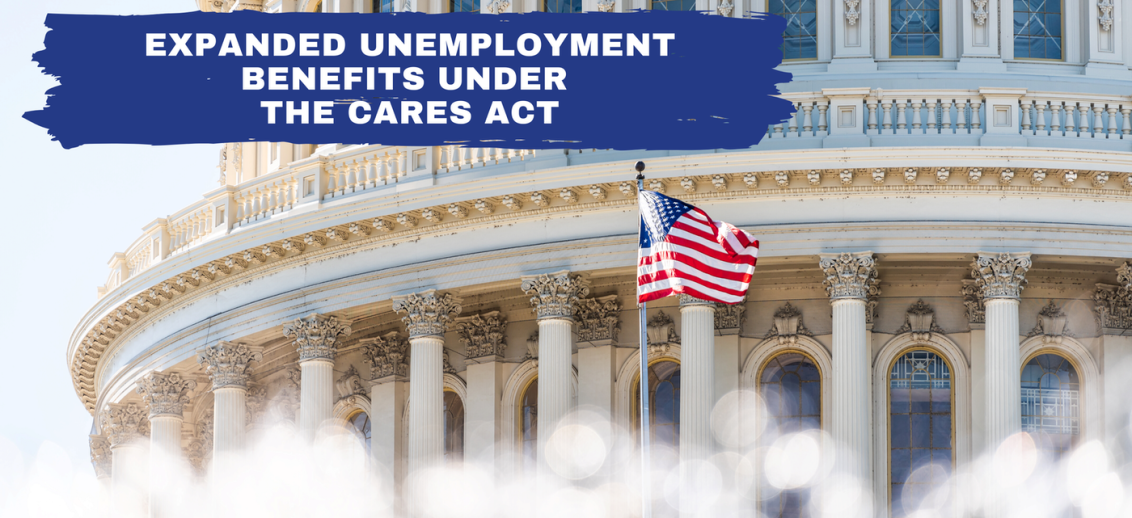With millions of American workers suffering lost wages due to layoffs, reduced hours, or furloughs related to COVID-19, expanded unemployment benefits are a key component of the $2 trillion Coronavirus Aid, Relief, and Economic Security Act (the “CARES Act”). Unemployment benefits under the CARES Act provide more money to more categories of workers than was previously available under existing state and federal law. This expanded unemployment compensation is referred to as federal pandemic unemployment assistance.
Highlights include:
- Expanding eligibility criteria for workers suffering income losses relating to COVID-19
- Allowing workers to “self-certify” that they meet these new criteria
- A temporary $600 per week increase in addition to existing unemployment benefits
- New personnel challenges and questions for employers
These provisions are primarily found in Sections 2102-2115 and 3603 (www.congress.gov/bill/116th-congress/house-bill/748/text). See details below.
Who is Entitled to Pandemic Unemployment Assistance?
The CARES Act provides pandemic unemployment assistance to a broad group of individuals. This includes new categories such as self-employed workers and independent contractors. The CARES Act also offers benefit eligibility to employees who quit their jobs for reasons related to COVID-19, thus extending eligibility to individuals who would not otherwise receive unemployment compensation under existing state or federal law. Individuals are now also permitted to “self-certify” that they are otherwise able and available to work under state law, but that they cannot work for reasons related to the COVID-19 public health emergency.
These reasons for which employees can “self-certify” include:
- The individual has been diagnosed with COVID-19 or is experiencing COVID-19 symptoms and seeking a diagnosis;
- A member of the individual’s household has been diagnosed with COVID-19;
- The individual is providing care for a family or household member who has been diagnosed with COVID-19;
- A child or other person for whom the individual is a primary caregiver is unable to attend school or other facility that is closed as a direct result of COVID-19;
- The individual is unable to reach the place of employment because of a quarantine imposed as a direct result of COVID-19;
- The individual is unable to reach the place of employment because the individual has been advised by a health care provider to self-quarantine due to COVID-19 related concerns;
- The individual was scheduled to commence employment and does not have a job or is unable to reach the job as a direct result of COVID-19;
- The individual has become the breadwinner or major support for a household because the head of the household has died as a direct result of COVID-19;
- The individual has to quit his or her job as a direct result of COVID-19; (This one is especially unclear as we don’t know what justifies “having to” quit)
- The individual’s place of employment is closed as a direct result of COVID-19; or
- The individual meets any additional criteria established by the Secretary for unemployment assistance under this section.
Expanded unemployment assistance is also available to individuals who are self-employed, seeking part-time employment, do not have sufficient work history, or otherwise would not qualify for regular unemployment or extended benefits under state or federal law or pandemic unemployment compensation under other provisions of the CARES Act.
The following individuals are NOT eligible for expanded unemployment benefits under the CARES Act:
- An individual who has the ability to telework with pay; or
- An individual who is receiving paid sick leave or other paid leave benefits, regardless of whether the individual otherwise meets a qualification for receiving pandemic unemployment compensation.
Some of the most confusing parts of the new law are not resolved by the guidance issued by the U.S. Department of Labor, which includes statements that an employee need not even quit their job in order to receive unemployment benefits and that unemployment benefits can be paid to an individual who “leaves employment due to a risk of exposure.” This guidance is not particularly helpful, as it merely introduces more ambiguous language suggesting that the mere fear of “risk” might constitute a qualified reason for expanded benefits, thus paving the way for potential abuse or, at minimum, confusion and may cause employees to seek unemployment benefits due to a generalized fear of COVID-19.
How Much Will Workers Receive Through Pandemic Unemployment Assistance?
Under the CARES Act, eligible individuals can recover the following benefit amounts:
- The amount determined under state law (even if they were not eligible under prior state law criteria); and
- A temporary additional $600 per week (i.e., in addition to the amount available under existing state law).
Thus, in California, where the maximum unemployment benefit payment is $450 per week, the CARES Act would allow eligible workers to receive up to a total of $1,050 per week due to the federal pandemic unemployment compensation. However, the additional $600 per week payment is only offered through July 31, 2020. Note that not all workers are eligible for the maximum weekly benefit amount under state law. The state calculates California’s unemployment benefit amount for each worker based on earnings history and other related factors. The EDD Fact Sheet on How Unemployment Insurance Benefits are Computed can be found here.
Because of these expanded federal benefits, some workers may end up receiving more money in unemployment benefits than in wages that they would otherwise earn while actually working. There were objections raised to this risk of perverse incentives, since no American should earn more by not working than by working. However, the interest in expediting relief and, perhaps, incentivizing people to comply with stay at home orders apparently won the day in Congress.
How Long Can Workers Receive Pandemic Unemployment Assistance?
The CARES Act limits individuals to receiving pandemic unemployment assistance for a maximum of 39 weeks, unless Congress chooses to extend it further. These unemployment benefits may be sought for weeks of unemployment between January 27, 2020 and December 31, 2020, but the $600 per week increase is only through July 31, 2020.
The CARES Act expressly states that there will be no waiting period for eligible individuals seeking pandemic unemployment assistance. Along the same lines, California already waived the typical one-week waiting period for state unemployment benefits via Governor Newsom’s prior emergency orders, meaning that individuals can obtain unemployment benefits for the first week they are unemployed due to COVID-19-related reasons (though actual receipt of these payments by workers may still be delayed, pending the processing of an unprecedented volume of claims).
States Are Still Awaiting Further Guidance from the U.S. Dept. of Labor to Implement These Provisions
The CARES Act makes these additional unemployment benefits available to any state that desires to enter into an agreement with the Secretary of Labor. It is not yet clear when these agreements will be in place and how soon workers can begin collecting expanded benefits and additional payments under these broadened provisions. California’s unemployment agency, the EDD, is still awaiting further federal guidance on implementation of various provisions of these new laws.
Further information and updates from the California EDD can be found here and here.
Implications For California Employers
Employers may be rightly concerned that some employees will choose to apply for unemployment benefits instead of continuing to report to work, given the expanded eligibility criteria for pandemic unemployment assistance, for which employees can “self-certify.” The text of the CARES Act provides little guidance on how employers might address the validity of an employee’s “self-certification” to allow any oversight. The risk of potential abuse or fraud is troubling given that employees may, in some cases, stand to make more by staying home than by continuing to show up for work.
Additional implications may arise for employers who are currently operating an essential business, and thus have work available. Such employers may question whether it is permissible to terminate employees who are not reporting for work and who are also not on an approved leave of absence under applicable company policy. Specifically, employees may have self-certified that they are unable to report to work and sought to collect unemployment benefits under the CARES Act. Employers, on the other hand, may disagree with the validity of an employee’s self-certified reason. Because employees do not need to quit to be eligible for unemployment benefits under the CARES Act, employers may question the appropriate steps to take when they disagree with the employee’s self-certified assessment of whether the employee can report to work. Generally speaking, employers are not required to keep employees on the roster and continue employee health benefits if employees are not reporting to work, excepting protected leave situations. However, it is prudent to consult with your counsel before making any personnel decisions implicated by these developments, given the lack of clarity. Strategies and considerations for employers facing such decisions should be individualized depending on factors including the industry, workforce, and reported reasons and risks in question, with the approach tailored to the relevant circumstances.
We will continue to monitor for new developments and will post any updates or clarifications as they become available.



